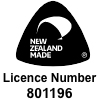2.16.1 General
Prior to undertaking any repairs information supplied may not reveal and detail all defects or pertinent information related to the condition of this building. Such information may be reliant on a full independent inspection report. Cracks will form in concrete, plasters and other cementitious surfaces as they cure and as a result of excessive movement, such as the building settling / structural movement or an earthquake.
The repairs below outline what you can do to repair each instance where the cracking is isolated. Where there is wide spread cracking of any of the following cracks then generally a full mesh system over the system will be sufficient, however you will want to investigate the substrate/structure further and further remedial work may be required.
2.16.2 Capillary Cracks
Their occurrence is not at all unusual and dealing with them is relatively straightforward. Concrete and plaster 'cure' as water used in the 'wet' mixture dries out, inevitably resulting in small surface or capillary cracks forming. They are easily covered by a paint system such as X200.
2.16.3 Minor Hairline (less than 1mm)
Hairline cracks are bigger or wider than capillary cracks, usually up to 1mm across. This is significant when you consider a layer of Resene Lumbersider is applied at only .035mm or in other words it would take 35 coats of Resene Lumbersider to achieve a paint film that was 1mm high. Hairline cracking often occurs as the cementitious surface (usually plaster or render) cures, especially if it is hot or dry, as water in the concrete mixture evaporates quicker than it would normally. Resene X-200 is ideal for brushing into hairline cracks with three coats easily filling a 1 mm crack. Alternatively, Resene Brushable Crack Filler may be used. Once the repairs have been completed you will need to coat the wall using 2 Coats of Resene X200.
2.16.4 Cracking (1-2mm)
Cracks larger than 1mm will need to have a plaster bandage applied over them prior to retexturing the wall surface. Where there are a number of cracks (regardless of size) to the wall surface then it is generally recommended that replastering and remeshing is undertaken.
2.16.5 Structural Cracking (Greater than 2mm)
Where cracking is greater than 2mm in width then the crack must be ground out, making sure to taper an area away from both sides of the crack. Apply Rockcote MultiStop (Refer to TradeSpec Document 4.8) and embed a strip of mesh no less than 75mm wide over the crack forming a bandage. You will then need to re-texture the entire wall with a mineral or acrylic based texture making sure that one coat of Limelock has been used as well as 2 coats of Resene X200.
2.16.6 Control Joint
A controlled Structural Crack is generally installed where there is a lack of a control joint (please refer to TradeSpec Document 1.2 – Design Construction for more information about Control Joints). A structural control joint is created in an existing plaster surface using an Electric Grinder or hand tools and should cut through the plaster and substrate. A control Joint should be between 6-12mm. Once formed a PEF Rod should be inserted into the control joint to form a good seal and then a MS Sealant is used to seal the newly formed control joint. In most cases a Control Joint will generally require taping either side of joint and repainting of the joint only.
2.16.7 Re-mesh Walls
Where extensive cracking or delamination has occurred over a wall then it you will need to replaster and embed mesh to the entire wall surface. First you should determine what has caused the cracking to the wall. Prior to undertaking any work that requires remeshing a wall make sure an independent report has been furnished to you that identifies the cause of the problems on the wall. You will need to make sure that other third parties complete any targeted repairs to other building components prior to you starting your plastering.
Delamination
Where delamination has occurred make sure that you remove all loose material, you will then need to provide a key for the new plaster to adhere to this would be a slurry of acrylbond and MultiStop (Refer to TradeSpec Document 4.7 for more information on forming a key coat).
Multiple Cracks
Where multiple cracks have occurred there will be a high probability that there is a need for a Control Joint to be formed. Follow the guidelines set out earlier in this TradeSpec to determine how to repair the multiple cracks.
Once you have remedied the cracks you will need to re-render and mesh the entire wall surface, make sure that you have applied a mixture of Acrylbond, Water and MultiStop to form a key before applying any renders (Refer to TradeSpec Document 4.7 for more information on forming a key coat). You will then need to retexture the entire wall with a mineral or acrylic based texture followed by 2 coats of X200.
2.16.8.Colour selection
For further information on Light Reflectance Values (LRV) refer to TradeSpec™ Document 1.6 – Light Reflectance Values






